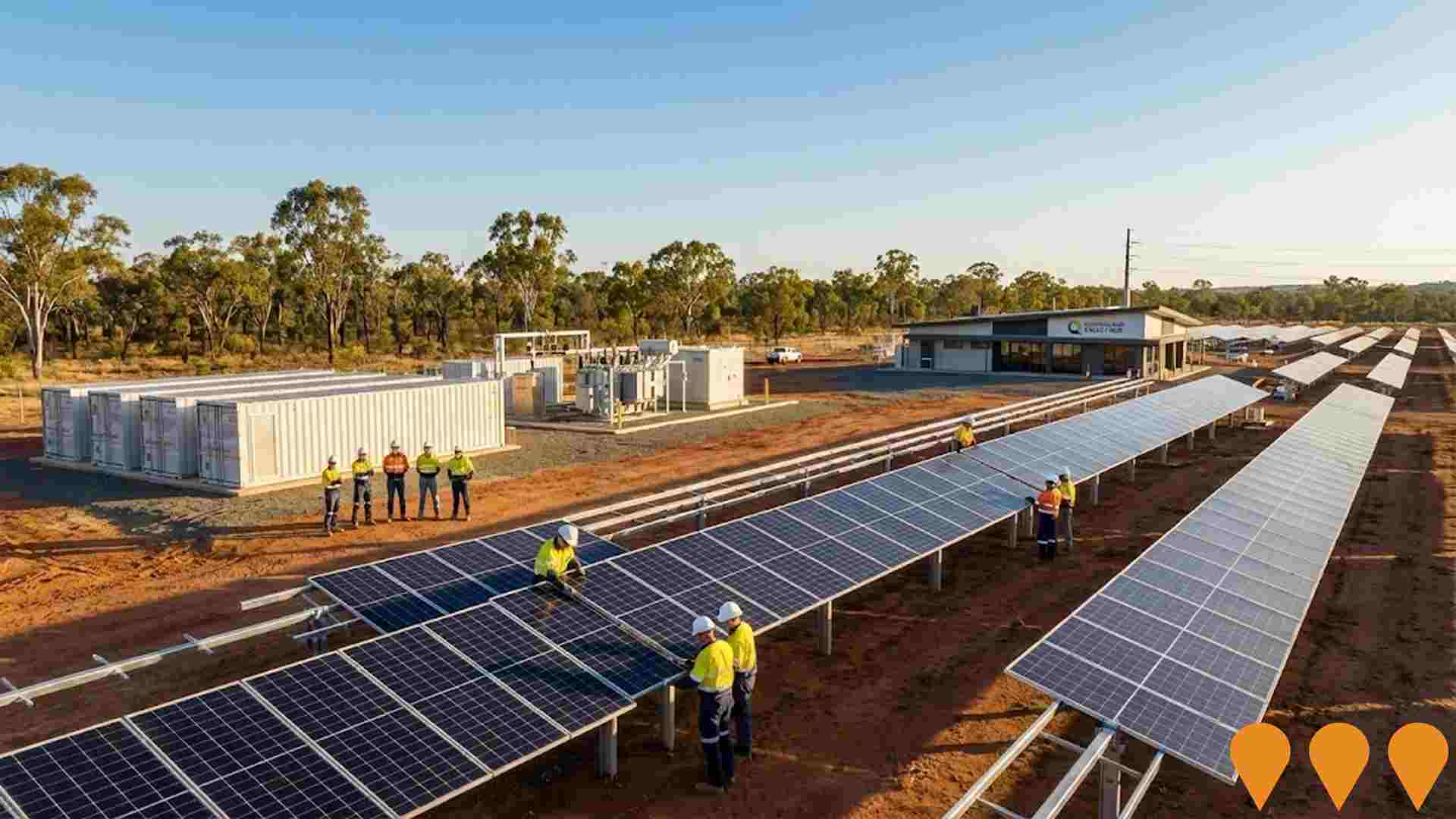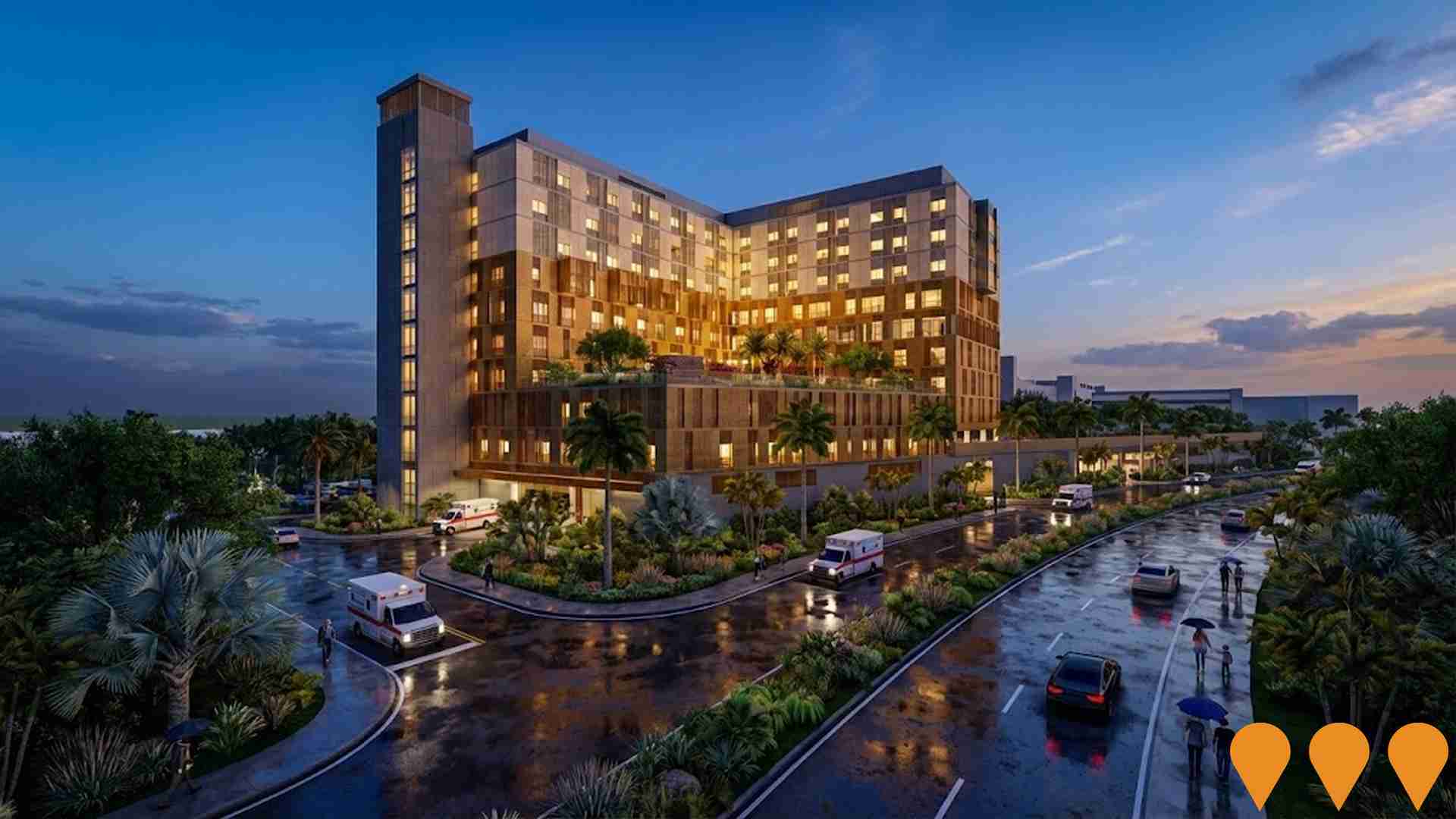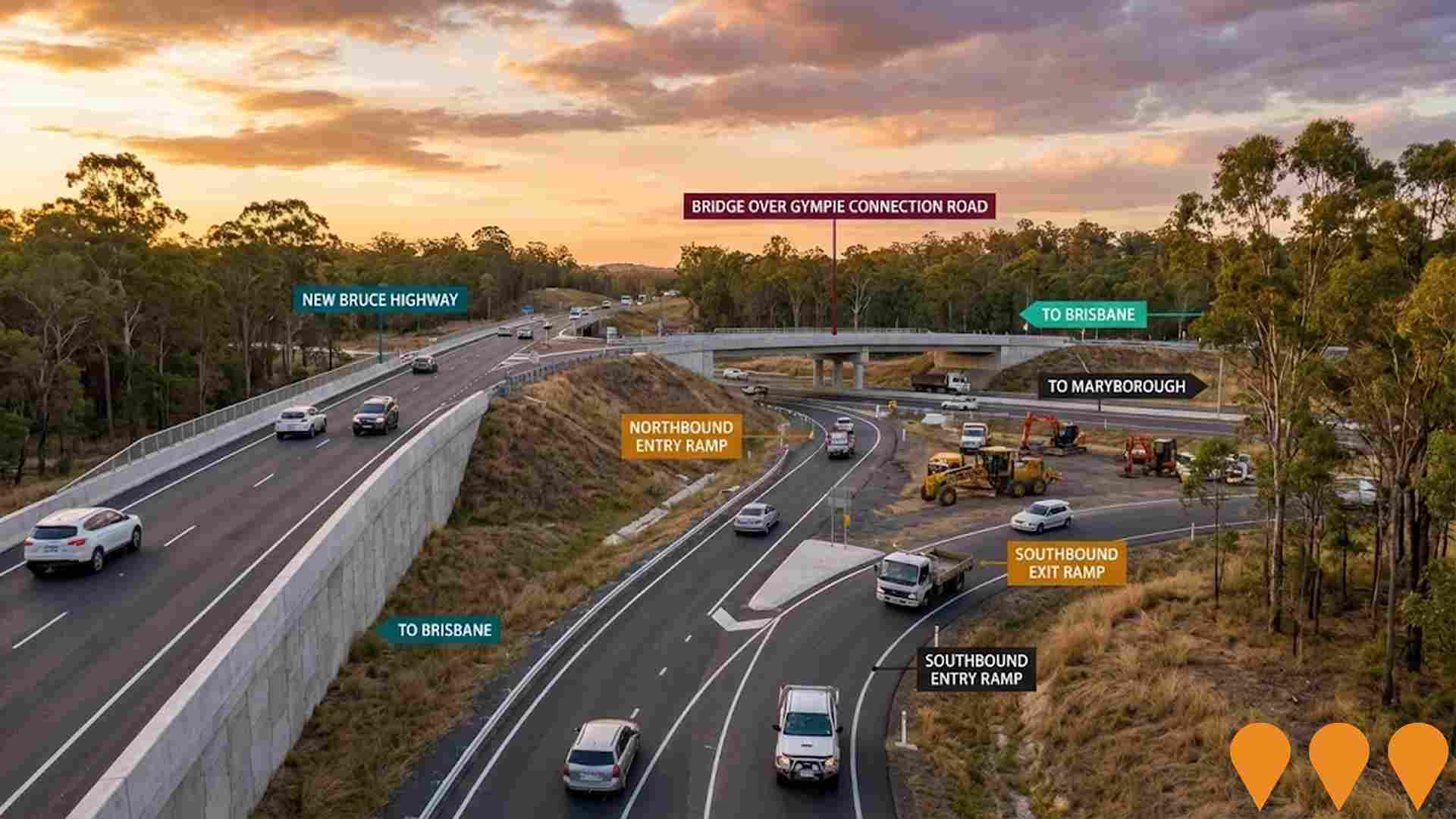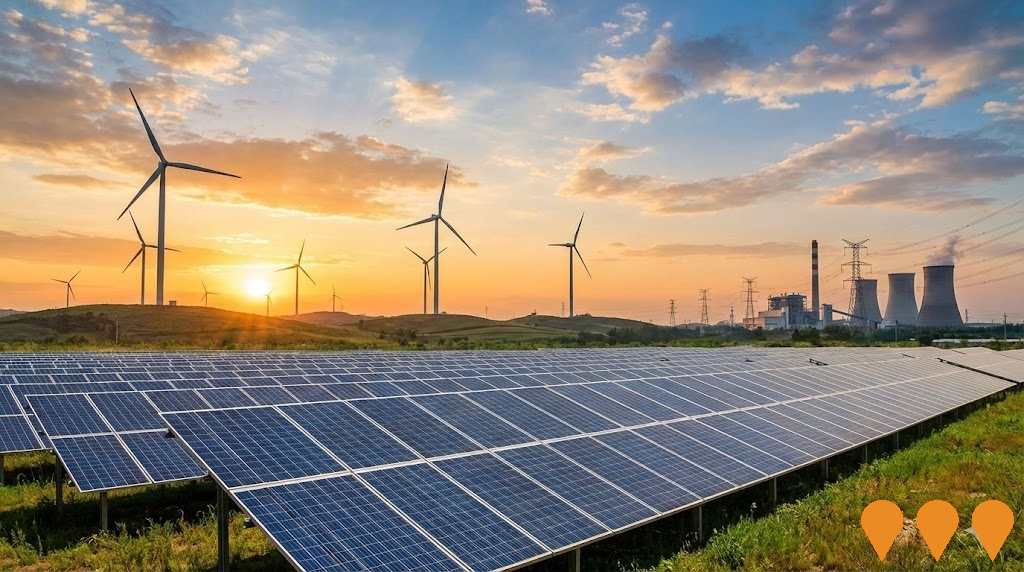Chart Color Schemes
est. as @ -- *
ABS ERP | -- people | --
2021 Census | -- people
Sales Activity
Curious about local property values? Filter the chart to assess the volume and appreciation (including resales) trends and regional comparisons, or scroll to the map below view this information at an individual property level.
Find a Recent Sale
Sales Detail
Population
Gayndah - Mundubbera has shown very soft population growth performance across periods assessed by AreaSearch
As of August 2025, Gayndah - Mundubbera's population is approximately 6,755. This figure reflects a growth of 360 people since the 2021 Census, which reported a population of 6,395. The increase was inferred from an estimated resident population of 6,668 in June 2024 and an additional 105 validated new addresses since the Census date. This results in a population density ratio of 0.80 persons per square kilometer. Gayndah - Mundubbera's growth rate of 5.6% since the census is comparable to its SA3 area, which grew by 6.0%. The primary driver for this growth was overseas migration, contributing approximately 97.3% of overall population gains.
AreaSearch uses ABS/Geoscience Australia projections for each SA2 area released in 2024 with a base year of 2022. For areas not covered by this data and years post-2032, Queensland State Government's SA2 area projections released in 2023 based on 2021 data are adopted. However, these state projections do not provide age category splits, so AreaSearch applies proportional growth weightings in line with ABS Greater Capital Region projections released in 2023 based on 2022 data for each age cohort. Based on projected demographic shifts, Gayndah - Mundubbera is expected to expand by 196 persons to 2041, reflecting an increase of approximately 1.6% over the 17-year period.
Frequently Asked Questions - Population
Development
Residential development activity is lower than average in Gayndah - Mundubbera according to AreaSearch's national comparison of local real estate markets
Gayndah-Mundubbera averaged approximately 16 new dwelling approvals annually over the past five financial years, from FY2021 to FY2025, totalling 84 homes. In FY2026 up to July, 7 dwellings have been approved. Over these five years, an average of 1.6 people moved to the area per dwelling built. However, this figure has increased to 5.2 people per dwelling over the past two financial years, indicating growing popularity and potential undersupply.
The average expected construction cost value for new homes is $300,000, which is below regional levels, offering more affordable housing options. This financial year, $6.6 million in commercial development approvals have been recorded, reflecting the area's residential character. Compared to Rest of Qld and national averages, Gayndah-Mundubbera shows approximately 75% of construction activity per person, placing it among the 41st percentile nationally, suggesting limited buyer options but strong demand for established dwellings. New development consists predominantly of detached dwellings (92%), maintaining the area's traditional low-density character focused on family homes.
The estimated population density is 402 people per dwelling approval, reflecting its quiet development environment. Future projections anticipate Gayndah-Mundubbera adding 109 residents by 2041, with current construction levels expected to meet housing demand adequately, creating favourable conditions for buyers and potentially enabling growth that exceeds current forecasts.
Frequently Asked Questions - Development
Infrastructure
Gayndah - Mundubbera has moderate levels of nearby infrastructure activity, ranking in the 40thth percentile nationally
Changes to local infrastructure significantly influence an area's performance. AreaSearch has identified five projects likely impacting this region. Notable initiatives include Stony Creek Wind Farm, New Paradise Dam Wall, Monto-Mount Perry Road progressive sealing, and Mt Rawdon Pumped Hydro Project, with the following list detailing those most relevant:.
Professional plan users can use the search below to filter and access additional projects.
INFRASTRUCTURE SEARCH
 Denotes AI-based impression for illustrative purposes only, not to be taken as definitive under any circumstances. Please follow links and conduct other investigations from the project's source for actual imagery. Developers and project owners wishing us to use original imagery please Contact Us and we will do so.
Denotes AI-based impression for illustrative purposes only, not to be taken as definitive under any circumstances. Please follow links and conduct other investigations from the project's source for actual imagery. Developers and project owners wishing us to use original imagery please Contact Us and we will do so.
Frequently Asked Questions - Infrastructure
Santos GLNG Project
Large-scale coal seam gas to LNG project comprising upstream gas field development in the Surat and Bowen Basins, gas transmission pipelines, and a liquefied natural gas (LNG) plant on Curtis Island near Gladstone. The project has been operational since 2015 with ongoing drilling and field expansion activities.

Arrow Energy Surat Gas Project
Major coal seam gas to LNG project in the Surat Basin involving drilling of thousands of wells, construction of field compression stations, central processing facilities and pipelines to deliver gas to Shell-operated Curtis Island and Gladstone LNG facilities. Joint venture between Shell and PetroChina (50/50).

Brisbane 2032 Olympic and Paralympic Games Infrastructure Program
The $7.1 billion infrastructure program for the Brisbane 2032 Olympic and Paralympic Games includes a new ~60,000-seat main stadium at Victoria Park (hosting opening/closing ceremonies and athletics), a new Brisbane Arena (Roma Street or alternate location), venue upgrades to QSAC and Suncorp Stadium, new and upgraded aquatic centres, athletes' villages, and supporting transport improvements across South East Queensland. The program emphasises existing venues where possible with targeted new builds for legacy benefit.

Queensland Energy and Jobs Plan
The Queensland Energy and Jobs Plan, initially a comprehensive plan for renewable energy and job creation, has been superseded by the Queensland Energy Roadmap 2025 by the new government (October 2025). The Roadmap focuses on energy affordability, reliability, and sustainability by leveraging existing coal and gas assets, increasing private sector investment in renewables and storage (targeting 6.8 GW of wind/solar and 3.8 GW of storage by 2030), and developing a new Regional Energy Hubs framework to replace Renewable Energy Zones. The initial $62 billion investment pipeline is now primarily focused on implementing the new Roadmap's priorities, including an estimated $26 billion in reduced energy system costs compared to the previous plan. The foundational legislation is the Energy Roadmap Amendment Bill 2025, which is currently before Parliament and expected to pass by December 2025, formally repealing the previous renewable energy targets. Key infrastructure projects like CopperString's Eastern Link are still progressing. The overall project is in the planning and legislative amendment phase under the new policy.

New Paradise Dam Wall
Construction of a new 12.6 m high roller-compacted concrete dam wall immediately downstream of the existing Paradise Dam on the Burnett River. The new wall will restore full water supply capacity (approximately 300,000 ML) and bring the dam up to modern safety standards after the existing structure was deemed irreparable due to foundation and concrete durability issues. Works include demolition/removal of the existing primary spillway, construction of a new secondary spillway, and associated river diversion works. Essential water security and flood mitigation infrastructure for the Bundaberg and Wide Bay region.

Building Future Hospitals Program
Queensland's flagship hospital infrastructure program delivering over 2,600 new and refurbished public hospital beds by 2031-32. Includes major expansions at Ipswich Hospital (Stage 2), Logan Hospital, Princess Alexandra Hospital, Townsville University Hospital, Gold Coast University Hospital and multiple new satellite hospitals and community health centres.

Mt Rawdon Pumped Hydro Project
The Mt Rawdon Pumped Hydro Project is a proposed 2 GW / 20 GWh off-river pumped hydro energy storage project that will repurpose the existing void of the Mount Rawdon gold mine as the lower reservoir and construct a new upper reservoir on adjacent land. The project is currently preparing an Environmental Impact Statement (EIS) for submission.

Stony Creek Wind Farm
Approved wind farm in North Burnett, QLD by Greenleaf Renewables and Enerfin. Up to 27 turbines (tip height up to 260m) and around 166-200 MW capacity. Federal EPBC and Queensland state approvals are in place for the wind farm. Transmission line route to connect to the Powerlink network has been finalised, with a development application to North Burnett Regional Council expected in the second half of 2025. Estimated construction start late 2026 with an 18-month build program.

Employment
Employment conditions in Gayndah - Mundubbera remain below the national average according to AreaSearch analysis
Gayndah - Mundubbera has a balanced workforce with white and blue collar jobs. Unemployment rate is 4.6% with an estimated employment growth of 7.1% in the past year.
As of June 2025, there are 3593 residents employed with an unemployment rate of 4.6%, which is 0.6% higher than Rest of Qld's rate of 3.9%. Workforce participation is lower at 52.8% compared to Rest of Qld's 59.1%. Key industries are agriculture, forestry & fishing, health care & social assistance, and education & training. Agriculture, forestry & fishing has a high employment share of 8 times the regional level.
However, health care & social assistance is under-represented at 10.9% compared to Rest of Qld's 16.1%. Many residents commute elsewhere for work based on Census data. Between June 2024 and June 2025, employment increased by 7.1%, labour force by 7.8%, raising unemployment rate by 0.6 percentage points. Rest of Qld had lower growth rates with employment up 1.8% and labour force up 2.0%. Jobs and Skills Australia's national employment forecasts from May 2025 suggest Gayndah - Mundubbera's employment could grow by approximately 4.8% over five years and 11.0% over ten years, based on industry-specific projections.
Frequently Asked Questions - Employment
Income
Income metrics place the area in the bottom 10% of locations nationally according to AreaSearch analysis
Gayndah - Mundubbera had a median taxpayer income of $38,026 and an average income of $45,885 in the financial year 2022, according to postcode level ATO data aggregated by AreaSearch. These figures are lower than national averages. In comparison, Rest of Qld's median income was $50,780 with an average income of $64,844 during the same period. By September 2025, estimated incomes would be approximately $43,346 (median) and $52,304 (average), based on a 13.99% increase from the financial year 2022 Wage Price Index growth. Census data indicates that household, family, and personal incomes in Gayndah - Mundubbera all fall between the 5th and 9th percentiles nationally. Income distribution shows that 30.2% of the population (2,040 individuals) earn within the $400-$799 range, differing from surrounding regions where the $1,500-$2,999 range dominates with 31.7%. Housing costs are modest, allowing for 88.6% of income to be retained, but total disposable income ranks at just the 9th percentile nationally.
Frequently Asked Questions - Income
Housing
Gayndah - Mundubbera is characterized by a predominantly suburban housing profile, with above-average rates of outright home ownership
In Gayndah - Mundubbera, as per the latest Census, 93.2% of dwellings were houses, with the remaining 6.8% being semi-detached, apartments, or other types. This is similar to Non-Metro Qld's figures of 93.4% houses and 6.6% other dwellings. Home ownership in Gayndah - Mundubbera stood at 48.1%, with mortgaged dwellings at 24.6% and rented ones at 27.3%. The median monthly mortgage repayment was $1,083, aligning with Non-Metro Qld's average, while the median weekly rent was $215, compared to Non-Metro Qld's $230. Nationally, Gayndah - Mundubbera's mortgage repayments were significantly lower than the Australian average of $1,863, and rents were substantially below the national figure of $375.
Frequently Asked Questions - Housing
Household Composition
Gayndah - Mundubbera features high concentrations of lone person households and group households, with a fairly typical median household size
Family households constitute 64.6% of all households, including 21.4% couples with children, 33.6% couples without children, and 8.3% single parent families. Non-family households comprise the remaining 35.4%, with lone person households at 31.4% and group households making up 4.1%. The median household size is 2.3 people, which aligns with the average for the Rest of Queensland.
Frequently Asked Questions - Households
Local Schools & Education
Gayndah - Mundubbera faces educational challenges, with performance metrics placing it in the bottom quartile of areas assessed nationally
The area's university qualification rate is 12.1%, significantly lower than Australia's average of 30.4%. This presents both a challenge and an opportunity for targeted educational initiatives. Bachelor degrees are the most common at 9.6%, followed by postgraduate qualifications (1.3%) and graduate diplomas (1.2%). Vocational credentials are prominent, with 39.1% of residents aged 15+ holding them - advanced diplomas (9.1%) and certificates (30.0%).
Educational participation is high at 27.2%, including 11.5% in primary, 9.5% in secondary, and 2.1% in tertiary education. There are 10 schools operating in Gayndah - Mundubbera, educating approximately 727 students, with typical Australian school conditions (ICSEA: 951) providing balanced educational opportunities. The mix includes 7 primary, 1 secondary, and 2 K-12 schools. School places per 100 residents are lower at 10.8 compared to the regional average of 14.0, with some students likely attending schools in nearby areas. Note: for schools showing 'n/a' for enrolments, please refer to their parent campus.
Frequently Asked Questions - Education
Schools Detail
Nearby Services & Amenities
Transport
No public transport data available for this catchment area.
Frequently Asked Questions - Transport
Transport Stops Detail
Health
Health performance in Gayndah - Mundubbera is well below average with prevalence of common health conditions notable across both younger and older age cohorts
Health data indicates significant health challenges in Gayndah - Mundubbera, with high prevalence of common conditions across both younger and older age groups. Only approximately 47% (~3,147 people) have private health cover, lower than the national average of 55.3%.
The most prevalent medical conditions are arthritis (12.1%) and mental health issues (8.0%). About 61.2% of residents report no medical ailments, slightly higher than the Rest of Qld's 59.4%. Around 26.5% (1,792 people) are aged 65 and over. Health outcomes among seniors present some challenges but perform better than the general population in health metrics.
Frequently Asked Questions - Health
Cultural Diversity
Gayndah - Mundubbera ranks below the Australian average when compared to other local markets across a number of language and cultural background related metrics
Gayndah-Mundubbera had a cultural diversity index below average, with 82.2% of its population being Australian citizens, born in Australia (86.3%), and speaking English only at home (92.3%). Christianity was the predominant religion, accounting for 58.8%, slightly higher than the regional average of 56.4%. The top three ancestry groups were Australian (31.5%), English (30.1%), and German (7.8%).
Notably, Australian Aboriginal representation was higher at 4.9% compared to the regional average of 6.0%. Korean and Samoan populations were also notably higher at 0.3% and 0.1%, respectively, compared to their regional averages of 0.1% and 0%.
Frequently Asked Questions - Diversity
Age
Gayndah - Mundubbera hosts an older demographic, ranking in the top quartile nationwide
Gayndah-Mundubbera has a median age of 47 years, which is notably higher than Rest of Qld's 41 and exceeds the national norm of 38. The 75-84 age cohort is significantly over-represented at 10.3% locally compared to the Rest of Qld average, while the 5-14 age group is under-represented at 10.2%. Between 2021 and present, the 25 to 34 age group has grown from 10.8% to 12.7%, and the 35 to 44 cohort has increased from 9.7% to 10.8%. Conversely, the 45 to 54 age group has declined from 13.0% to 11.4%, and the 65 to 74 group has dropped from 14.3% to 13.1%. Demographic modeling suggests that Gayndah-Mundubbera's age profile will change significantly by 2041. The 85+ age cohort is projected to grow significantly, expanding by 162 people (78%) from 208 to 371. Notably, the combined 65+ age groups are expected to account for 52% of total population growth, reflecting the area's aging demographic profile. In contrast, population declines are projected for the 45 to 54 and 65 to 74 cohorts.



